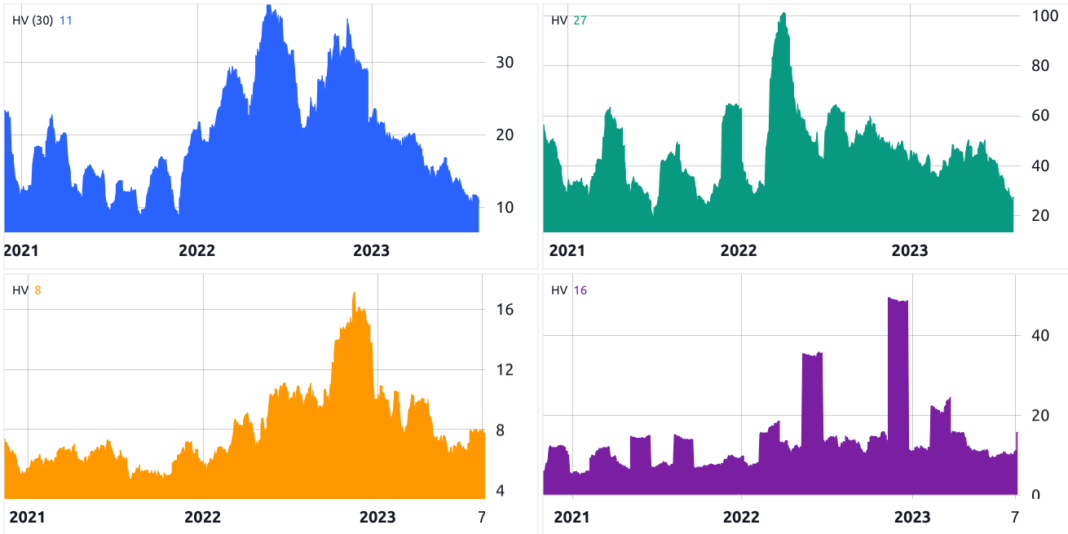The most recent report from Glassnode Insights, titled “The Week On-Chain,” emphasised that Bitcoin (BTC) has reached traditionally low ranges of volatility. This has led to a mere 2.9% separation between the asset’s Bollinger Bands, indicating an exceptionally slender buying and selling vary.
This example has solely been noticed twice in Bitcoin’s historical past: in September 2016, when BTC traded close to $604, and in January 2023, when the asset maintained a gentle worth of $16,800.
As outlined within the report, intervals of diminished volatility, mixed with investor fatigue, immediate the motion of cash based mostly on their value near the present value. This means that merchants are seemingly making marginal income or losses with their exits. The report concludes that establishing a brand new value vary is critical to stimulate contemporary spending, probably contributing to an anticipated improve in volatility.
Is Bitcoin’s low volatility a mirrored image of broader markets?
The constrained vary inside which Bitcoin has traded – particularly, $29,050 to $29,775 over the previous three weeks – is atypical and it doesn’t require superior mathematical evaluation to grasp. This has resulted in an exceptionally low annualized 30-day volatility of 17%. The important thing query is whether or not this pattern is remoted to cryptocurrencies, or if it is a phenomenon additionally noticed within the conventional markets, together with shares, oil, bonds and currencies.
Discover how the S&P 500 and oil value (WTI) 30-day volatility are presently at their lowest ranges since November 2021. Curiously, the DXY index did not observe this pattern, because the metric rose to eight% from 6% in Might 2023. Moreover, the 10-year Treasury yield not too long ago rose from its 18-month low of round 10% to the present 16%. These tendencies may have probably influenced the lower in Bitcoin’s volatility.
In response to Glassnode, there is a important focus of short-term holders’ value distribution between $25,000 and $31,000. This sample is harking back to related intervals throughout previous bear market recoveries. Nonetheless, the info reveals that many of those buyers are nonetheless holding positions with losses, creating short-term promoting stress.

Furthermore, the analytics agency highlights a noteworthy drop in short-term holder provide to a multi-year low of two.56 million BTC. On the flip aspect, the provision held by long-term holders has reached an all-time excessive of 14.6 million BTC, as talked about within the report.

Assuming a comparatively optimistic state of affairs the place solely 10% of the 1.77 million BTC held by long-term buyers at $47,000 or greater change their positions earlier than Bitcoin surpasses $40,000, this quantities to about 6 and a half months of the present mining output. This illustrates the significance of not disregarding the potential impression of a worldwide financial recession on Bitcoin’s value, past the truth that short-term holders have gotten scarce.
This speculation would not invalidate Glassnode’s concept of elevated positions by “long-term conviction holders.” However, no historic knowledge can account for the U.S. 10-year Treasury yields nearing their highest stage in 16 years or the 30-year mounted common mortgage charge within the U.S. flirting with the 7% mark.
Regardless of the present pattern, long-term holders nonetheless may flip their sentiment and actions within the creation of opposed financial situations.
Larger yields in equities may entice buyers, resulting in doable volatility, whereas rising authorities and company borrowing prices would possibly pressure budgets and profitability. Concurrently, actual property markets would possibly gradual because of the impression on mortgage affordability. Such circumstances would seemingly compel central banks to implement fiscal insurance policies to assist financial exercise, typically leading to upward inflation stress.
Bitcoin’s ascension as a $50 billion asset class occurred merely 6 years in the past, making it unsure how holders will react to the stress confronted by some conventional markets. This contradicts the traditionally low volatility within the S&P 500, oil and Bitcoin markets.
This raises the query: may this tranquility be previous a interval of turmoil and can Bitcoin function a hedge towards escalating inflation? Solely time will present the solutions.
This text is for basic data functions and isn’t supposed to be and shouldn’t be taken as authorized or funding recommendation. The views, ideas, and opinions expressed listed here are the writer’s alone and don’t essentially replicate or characterize the views and opinions of Cointelegraph.


